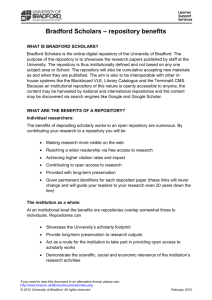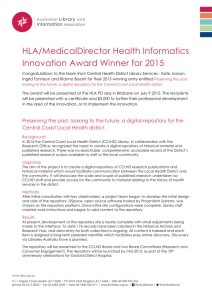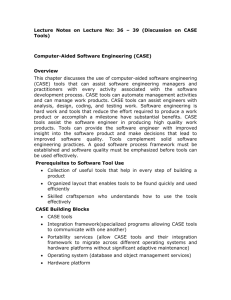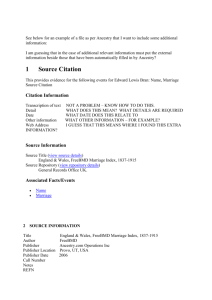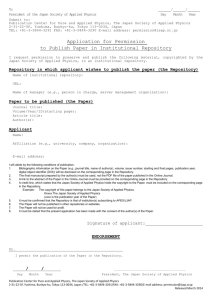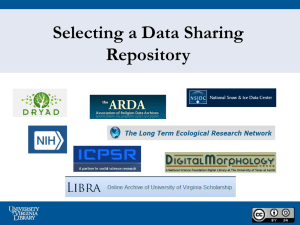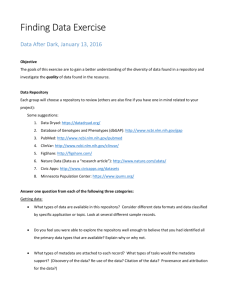Kfir, Rivka. Knowledge Management Sixth SA
advertisement
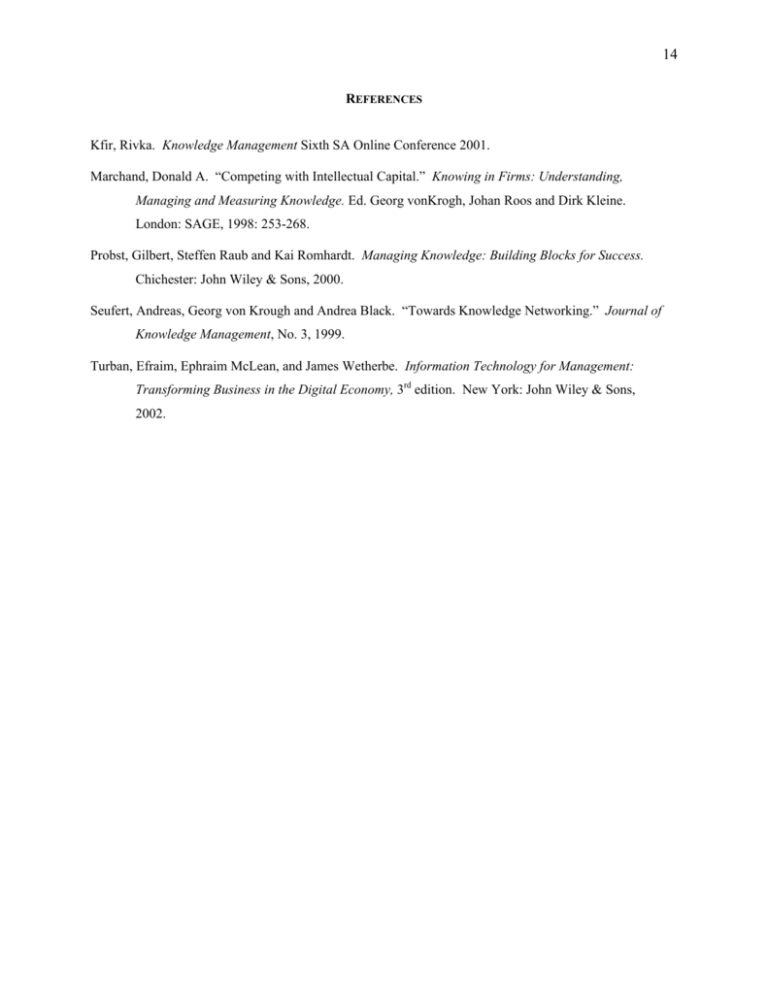
14 REFERENCES Kfir, Rivka. Knowledge Management Sixth SA Online Conference 2001. Marchand, Donald A. “Competing with Intellectual Capital.” Knowing in Firms: Understanding, Managing and Measuring Knowledge. Ed. Georg vonKrogh, Johan Roos and Dirk Kleine. London: SAGE, 1998: 253-268. Probst, Gilbert, Steffen Raub and Kai Romhardt. Managing Knowledge: Building Blocks for Success. Chichester: John Wiley & Sons, 2000. Seufert, Andreas, Georg von Krough and Andrea Black. “Towards Knowledge Networking.” Journal of Knowledge Management, No. 3, 1999. Turban, Efraim, Ephraim McLean, and James Wetherbe. Information Technology for Management: Transforming Business in the Digital Economy, 3rd edition. New York: John Wiley & Sons, 2002. 13 knowledge, any system dedicated to knowledge preservation is at risk of becoming obsolete or bloated with useless information. Knowledge management procedures are essential to maintain the currency and relevance of the knowledge repository, adding costs and complexities not required by other models. Centralization of knowledge in a repository can make it more vulnerable to tampering or destruction if appropriate risk countermeasures are not included in the design. Accidental loss of the physical artifact could be prevented by building redundancy. User authentication becomes critical additions to avoid hostile intelligence gathering by competitors. The overall security of the knowledge repository is unquestionable, but the costs to prevent or alleviate all threats must be balanced against the cost of losing knowledge integrity. The chief benefit of the network model is its ease of implementation, especially given modern communications technology. The distributed nature of the system means that new nodes can be integrated into the system. Interaction with the system is more direct and personal, making it easier for an organization to judge if the system is successful. These benefits must be balanced with factors such as the limited storage capacity of a knowledge network. The transient nature of employees, who may leave the company or retire, means that the system is impermanent. The network must be able to update records as organizational members gain new skills. There are also the difficulties that may arise in trying to codify employees’ tacit knowledge. The same distributed configuration that makes the network system appealing can also make maintaining data security more challenging. Whichever type of system that is chosen for implementation must complement the knowledge to be stored and its function within the organization. This decision cannot be taken lightly as it will have far reaching repercussions for an organization’s intellectual capital. Weighing the advantages and disadvantages of each model and deciding which suits the organization’s needs is the first challenge in the implementation of a knowledge management system. 12 implemented normative knowledge strategies at the operational level. Cultural changes toward a more knowledge-friendly workplace can be identified by questioning and observing employees. One drawback of this technique is a perceived sense of achievement by looking only at internal objectives. To avoid this deception, strategic benchmarking should be added to include the competencies of competitors. CONCLUDING REMARKS Once a system is chosen for knowledge management by ascertaining the kind of intellectual capital the organization wants to store, standards and checks must be put into place to make sure the system is providing appropriate value. These can be qualitative criteria such as single use studies or purely quantitative asset-based approaches. Many knowledge management systems fail, often due to factors such as a lack of planning regarding what knowledge to retain, or how to incorporate the system in the organizational culture. Knowledge management systems that do succeed supply proven benefits in the form of financial returns on the investment of implementing the system or in the connection of stored knowledge with business applications and practices [Turban et al., 2002]. We looked at two knowledge management models in this paper: the knowledge repository and the knowledge network. Each archetype was studied and analyzed in detail. Tactical considerations were discussed as part of the implementation. The following table compares the two models in some key areas and summarizes our findings. KNOWLEDGE REPOSITORY KNOWLEDGE NETWORK High Low Permanent Transitory Vertical Horizontal Technical Sociological Normalized Variable STORAGE CAPACITY Unlimited Limited SYSTEM CONFIGURATION Centralized Distributed USER INTERACTION Impersonal Personal IMPLEMENTATION COST INTELLECTUAL LONGEVITY KNOWLEDGE FLOW KNOWLEDGE MANAGEMENT FOCUS INFORMATION QUALITY CONTROL Table 1: Comparison of Knowledge Repository and Knowledge Network Models The major benefit of a knowledge repository is its posterity. As employees, programs, and products come and go, the repository remains as both an institutional archive and a resource that can be used across the organization. This advantage comes with a price. Because of the dynamic nature of 11 of tacit and explicit knowledge with a high rate of availability and absorption. Therefore, in order to support the social relationships necessary for this the manager must incorporate the principles of a facilitator into his role. By focusing on social relationships as the primary means of knowledge management, the network model is able to utilize the tacit knowledge of an organization’s employees in a much more efficient manner than the repository model. However, the collective organizational knowledge, i.e. the organization’s intellectual capital, is often greater than the sum of knowledge of its employees. This synergistic effect can only be realized if the means of knowledge storage and transmission are operating to their fullest extent. Given that in the network model the primary storage is with individual minds within the organization (something the knowledge manager generally has little control over), the role of social relationships cannot be underestimated. Therefore, it is essential for knowledge management that new models of management and organization for the Information Economy incorporate these ideas of trust, flexibility, and specialization. MEASURING KNOWLEDGE To measure the success of knowledge management, knowledge itself must be appraised. Since the value of knowledge depends on circumstance, it is almost impossible to quantify knowledge objectively [Probst et al., 2000: 244-250]. To do so would require the separation of knowledge from its context, including time and people. But knowledge is both dynamic and personal, a function of human interaction in a particular timeframe. A purely quantitative approach to measuring organizational knowledge is unrealistic. The traditional techniques for calculating the monetary value of tangible resources are inadequate to measure intellectual capital because organizational knowledge does not behave like traditional assets of production. In traditional accounting systems, knowledge can only be given a concrete financial value after it has been incorporated into profitable goods. Accounting of the intellectual capital is insignificant for strategic planning of the organizational knowledge base because bookkeeping can only offer a retrospective viewpoint. Evaluating knowledge this way may involve assigning a monetary value to someone’s expertise or the future significance of existing technologies. This could impact the power structure of an organization, turning knowledge management into a political battlefield. A more promising approach is to understand causal relationships in the knowledge management cycle and assess progress in terms of qualitative indicators. Competencies can be evaluated in relation to predefined strategic knowledge goals [Probst et al., 2000: 259-266]. The method involves checking whether all parts of the organization are aligned with the knowledge vision and whether they have 10 organization. Also, the breadth of each individual’s knowledge can be more explicitly quantified by adding keywords to each person’s contact information representative of his or her fields of specialization. By having the contact information and effective keyword descriptions in a central repository, the knowledge manager can take advantage of the stability and accessibility of a repository model to further increase the speed, flexibility and specialization of a network model. Another advantage of the network model is the ease in which an organization that has implemented knowledge networks can take advantage of increased global connectivity between organizations and individuals. With the growing ubiquity of the Internet and devices that can access it, knowledge networks are no longer restricted to the organizational intranet. By focusing on a relationship and communication-based knowledge structure, an organization can more easily incorporate and merge incoming knowledge from external sources. The capability to more readily exploit and utilize knowledge, capabilities and resources distributed in networks, both inside and outside of the organization, gives that organization a distinct competitive edge over one relying solely on a repository-based model. However, the success of a network model is dependant on several factors which are much more difficult to regulate than in a repository model. Because the rate at which knowledge is transmitted and utilized is dependant on social relationships, knowledge management takes on a much more psychological role than technical. Rather than monitoring the bandwidth of cables and routers, the knowledge manager monitors language, open-mindedness, creativity and tolerance of others’ ideas. The knowledge manager becomes responsible for supporting an organizational culture that has to be willing to share knowledge, which requires a trusting and comfortable environment. To maximize knowledge flow, the manager must also promote an organizational culture willing to participate in multidisciplinary groups, willing to ignore the normal biases and mental dividing lines separating individuals from different departments. It can be an enabling or an inhibiting environment for knowledge creation and transfer, and care must be taken by the knowledge manager to promote lenience in judgment and an active approach to prevent knowledge islands from forming. The biggest obstacle to a network model is this sort of knowledge isolation. Gap analysis – locating the source of communication breakdown and re-establishing relationships for the transfer of knowledge becomes an important responsibility and another of the psychological aspects of the knowledge manager’s job. Another important consideration for the knowledge manager is finding the balance between respect for privacy and the needs of the organization. Because the network model is dependant on social relationships as its primary means of transmission, it is possible for knowledge islands to form not only from situations such as departmental clique-ishness, but from individuals unwilling to participate or contribute to the networking process. As stated above, in order to ensure knowledge transfer remains at its maximum effectiveness in the network model, it must be a combination 9 an environment of trust and also by taking an active role as facilitator in guiding the quality and usefulness of the knowledge. By instructing in the use of imagery, metaphor, visual aids, etc., the knowledge manager can encourage refinement and systematization of the knowledge. This not only renders the knowledge more useful to those immediately receiving it, aiding in the internalization process and speeding the rate of absorption, it can also increase its applicability across the entire organization and make it more widely available for use. Another important consideration for management is the integration of several different types of knowledge. Because the majority of knowledge is not stored in a central repository, the manager will have to merge incoming with previous knowledge on several different levels. Individual types (tacit/explicit) will have to be combined with larger types (group, organizational) as well as combining the different areas of specialization (R&D, sales, marketing) from each of those levels. Each different area will be contributing knowledge with differing degrees of specificity and relevance, and in order to insure usefulness the manager will need to be constantly evaluating and updating the flow between those involved. The manager will also have to merge the various types of networks. Interaction occurs in many different types of places, both real (office, sales floor) and virtual (intranet, internet, email). A common solution is for the knowledge manager to use distributed groupware technology effectively in order to preserve a formal networking structure. The textbook suggests using collaborative computing systems such as Lotus Notes/Domino server [Turban et al., 2002: 407], but there are many other applications available. What is most important for maintaining a formal structure is keeping accurate and consistent metadata of the relationship, and transmitting the knowledge in case review. However, not all knowledge will be transferred via the formal networking structure and so the manager must also be prepared for all the informal networking via telephone and e-mail and be capable of merging that into the formal structure. Tactical Considerations with the Knowledge Network Model The primary advantage of the network model is its ease of use and implementation. On its simplest level, no additional technological resources are necessary because the knowledge remains distributed in the heads individuals and collective knowledge of the organization. Therefore the knowledge management primarily consists of keeping some sort of record of who knows what and how they can be contacted when necessary. However, should the organization decide to broaden the scope of its knowledge, the network model can be expanded in several different ways. By adding a repository consisting of some sort of accessible and searchable database, the contact information can be made more readily available to the 8 codification of knowledge distribution across the network and establishing the means for accessing it. In other words, a repository is necessary if for no other reason than for storage of the explicit knowledge about the tacit knowledge [Turban et al., 2002]. In the network model, the primary source of knowledge within an organization is the tacit knowledge of the people involved. However, this tacit knowledge – such as individual actions, experience, ideas or values – isn’t readily accessible independent of person and context. Therefore, a network of relationships is necessary to facilitate transfer of knowledge from one person, group or organization to the next. Modern communication technologies such as email, business intranet yellow pages, knowledge maps, etc., are only capable of transmitting explicit knowledge already quantified and stored in various media. In order for knowledge management to be most effective, some combination of explicit and tacit knowledge must be available. A network must be established in such a way that such subjective insights, personal abilities and “know-how” can be transmitted from agent to agent as readily as cold, hard facts. Therefore, the network model becomes dependant on social interaction and relationships between the actors as the primary means of distributing knowledge. Once shared this way, tacit knowledge is first converted to explicit knowledge through whatever form that particular relationship involves (conversation, email, memo, etc.). Once the target has received the knowledge and (hopefully) internalized it, it once again becomes tacit knowledge, now shared across the breadth of the actors involved. Using a network based on relationships, then, can result not only in a method for the transmission of externalized intuitive and personal knowledge, but also a method for the transmission from an individual to a much larger group. Because of the difficulty of accurately conveying tacit knowledge, several crucial factors must be taken into consideration when managing a network-based model. As stated above, the strategic and competitive advantages of knowledge for an organization depend on the capacity of that organization’s collective intellectual ability to generate, comprehend and utilize new knowledge. Therefore, the knowledge manager needs to be concerned with the rate of availability, i.e. the rate at which new knowledge is accessible to everyone necessary, and the rate of absorption, i.e. the rate at which those with access to the information are able to understand, internalize and act upon the new knowledge. The primary concern is the language of the communication, which directly correlates to the rate of availability and the rate of absorption. Tacit knowledge is by definition difficult to transfer or communicate due to its subjective and internal nature. In addition, sharing tacit knowledge through various levels and types of relationships with an organization requires trust. As with the repository model, all parties involved must perceive trusting other individuals with personal knowledge, thoughts or beliefs as a useful endeavor [Marchand, 1998]. The knowledge manager can ensure this perception by creating 7 THE KNOWLEDGE NETWORK MODEL Definition of a Knowledge Network In the knowledge network model, the knowledge remains distributed across acting agents within whatever boundaries have been defined due to the requirements of a specific project, a department or a business. Because the knowledge isn’t stored in a central location, the focus of this model is the relationships between the actors involved, which can be “persons, groups . . . collectives of organizations, communities, or even societies” [Seufert et al., 1999: 2]. Rather than being transferred vertically as in the person-to-repository model, knowledge transfers in a horizontal direction via social interaction and collaboration between individuals within a structure defined by the content and form of these relationships [Figure 2]. KNOWLEDGE NETWORK ? ! ? ↔↔↔↔ Figure 2: Knowledge Flow in the Knowledge Network Model Therefore, valuable knowledge flows from person-to-person and the network acts as a dynamic structure, rather than being deposited in a central repository and static institution. Like the repository model, some amount of knowledge about the knowledge, metadata, is required for structural purposes but it is usually only necessary to create a directory of who knows what rather than a thoroughly detailed index. In addition, instead of relying on data-warehousing technologies for capturing and storing knowledge, the network model works through communication technologies [Turban et al., 2002]. Implementation of a Knowledge Network Model It is recognized in all the sources covered in the scope of this paper that knowledge is increasingly becoming recognized as an important source of competitive advantage, and that advantage is dependant on the capability of an organization to constantly create new knowledge. This ability is the product of the collective intellectual ability of the organization, and of the organization’s capacity to absorb and digest knowledge from sources in the company and from outside, both in the public and private domains. The first and most important step in implementation of the network model, then, is the 6 attention to interpret every piece of information related to a particular task or topic. Without proper maintenance, knowledge repositories could grow extremely fast, leaving users with the overwhelming task of searching for relevant information in a haystack of data. Like the inherent risks of the knowledge repository model, the benefits associated with this model are palpable. The most noticeable is the preservation of organizational knowledge. Since intangible assets like knowledge have become essential to business success, investing in reliable methods for securing this resource are now obligatory. The collective skills and experiences of people are the framework of intellectual capital in any organization. Re-engineering, outsourcing and lean management practices could jeopardize this critical asset unless it is elicited from its individual owners and preserved for posterity. The knowledge repository model can alleviate and even eliminate the loss of intellectual capital. Compared to human memory which can be limited and transitory, a well-designed knowledge repository can be reliable and vast. Ubiquitous computing makes digital artifacts a natural choice to secure intellectual capital. Decreasing cost of storage devices allows for substantial amounts of information to be accumulated using digital knowledge repositories. Computers also provide the ability to process large amounts of information considerably faster than humans can, reducing the impact of data overflow. The centralization of the knowledge management process in a repository enables the organization to deal more efficiently with issues of knowledge obsolescence and source authority. As long as the information in the repository stays relevant with environmental changes, the risk of making decisions using outdated or unreliable knowledge sources can be prevented. Having valuable information in one place reduces the need to scavenge for it across the organization. This characteristic can increase the productivity of individuals who are no longer required to establish their own information networks to remain knowledgeable. Employees can feel empowered and more satisfied when knowledge is made available to them. Personal development and new skills flourish, creating new organizational knowledge. The knowledge repository model raises some ethical dilemmas and management challenges. Do individuals become expendable once their tacit knowledge is elicited and secured by the organization? Utilitarian managers may rationalize workforce reductions by putting the welfare of the company first. By doing so, however, they might compromise the atmosphere of trust that is essential for any successful knowledge sharing endeavor. Can management nurture an atmosphere of trust while harvesting the efficiencies created by newly acquired intellectual capital? Is knowledge management an alternative to downsizing or its latest catalyst? These strategic predicaments can be difficult to answer but are inherent to the new Information Economy of the 21st century. 5 in the knowledge system declines, reducing corporate support until it collapses. Currency of the information captured in the repository is critical to avoid this downward spiral. Knowledge repositories require dedicated staff to remain effective and current. The role of the knowledge manager should be to examine, structure, filter, catalogue, and store knowledge so that it is meaningful to the people who need it [Turban et al., 2002: 415-424]. This task never ends since organizational knowledge is always evolving and adapting to changes in the environment. Tactical Considerations with the Knowledge Repository Model Turning tacit knowledge into explicit information artifacts for broader distribution requires trust. Trusting other individuals with personal knowledge, thoughts and beliefs must be perceived by all parties involved as a useful endeavor [Marchand, 1998: 257-258]. By sharing knowledge, we trust other people not to use it against us in a competitive sense. There is a risk of betrayal associated with any knowledge sharing initiative, both at the individual and organizational levels. Corporate culture must reward those who share their knowledge to counteract the feeling of vulnerability that is often associated with this activity. Another risk related to knowledge sharing has to do with the currency of information. Once personal knowledge is stored in artifacts such as documents, messages or databases, it is frozen in time. Due to the dynamic nature of knowledge, however, it is highly possible that the stored information would become dated over time. Important decisions and actions could be executed based on knowledge that is already outdated or might become inaccurate later. This threat underscores the importance of knowledge management practices dedicated to monitor information currency. A challenge facing knowledge managers is dealing with old knowledge. Environmental changes can have unpredictable effects on the operational patterns of an organization. When previous experiences, skills and practices can no longer meet current challenges, organizations must forget the old ways of doing business and adapt to their new situation. Unlearning means being ready to question established routines and to let go of the familiar [Probst et al., 2000: 220]. The problem is to decide whether knowledge assets can be destroyed without harming future performance. Since new organizational knowledge can only be developed on the basis of previous knowledge, the elimination of existing knowledge must be carefully executed. Information overflow can become one of the most frequent perils of knowledge repositories. Technological advances in communications have created a global network of accessible information sources. However, the main factor in the knowledge creation activity—people—has remained unchanged. Humans have a limited capacity to analyze large quantities of data in a short amount of time. Even with the assistance of digital devices such as desktop computers, most persons lack the time or the 4 depends on the interaction of people and the continuous transformation of knowledge into information and vice versa. Information becomes the intermediate step in the constant permutation of knowledge. The benefits of knowledge management will elude those organizations that fail to distinguish knowledge from information and data. A methodology for capturing and retaining knowledge must reflect the idiosyncrasies of knowledge itself. Knowledge repositories require information about the information being stored, also known as metadata. Without this new layer of information, the context in which knowledge has been created and applied would be lost. Information without context becomes simple data void of meaning or purpose. Metadata is what separates knowledge repositories from traditional databases or data warehouses. The notion of technology managing information must shift to the idea of technology as a medium of relationships. This change in the role of technology is essential for the successful deployment of knowledge management systems. Under this new paradigm, the knowledge repository can be defined as a communication tool with posterity, a means to transfer knowledge into the future. Implementation of the Knowledge Repository Model Organizations looking to preserve their intellectual assets using a knowledge repository must establish three key processes: selection, storage and updating [Gilbert Probst, Steffen Raub and Kai Romhardt, 2000: 218-240]. First, organizations must select from their multitude of events, people and processes those worth retaining. Only knowledge that might be useful to other people in the future merits preservation. Attempting to store all kinds of knowledge would be wasteful. At the same time, it would be impossible to predict future information needs with absolute precision. Therefore, the search for useful knowledge should not be too narrow. Second, organizations must store their experience in a suitable form. Human memory can be transitory and dynamic, changing with every new experience. Technology offers a wide variety of options for information storage that are reliable and permanent. Organizations should take advantage of modern digital artifacts to secure their intellectual capital. Decreasing costs of computing equipment are making information storage very affordable. This trend guarantees an almost unlimited storage capacity, especially for large organizations building digital knowledge repositories. Databases and data warehouses can become part of the knowledge management system as long as they can be structured around the idiosyncrasies of knowledge. For example, electronic document management systems are textbased information databases more suited for capturing tacit knowledge. Finally, organizations must ensure the corporate memory gets updated periodically. If managers fail to maintain their knowledge repositories up to date, information quality becomes questionable. Trust 3 Definition of Knowledge Repository In the knowledge repository model, a central location for storing documented knowledge is established. Tacit knowledge flows from person-to-repository and from repository-to-person rather than from person-to-person [Figure 1]. Capturing tacit knowledge is the main objective of the knowledge repository [Turban et al., 2002: 396-399]. KNOWLEDGE REPOSITORY Figure 1: Knowledge Flow in the Knowledge Repository Model A knowledge repository can take many shapes. “Paper is perhaps the most powerful and prevalent means in most organizations through which people create documents and messages to express their knowledge…” according to Donald Marchand [1998: 257]. In ancient times, clay tablets served to record and preserve important concepts. The library of the Assyrian king Ashurbanipal had a collection of 30,000 clay tablets circa 650 B.C. The Museion of Alexandria in Egypt—built during the Ptolemaic dynasty—housed a collection of 700,000 scrolls. One of the first public libraries in the world was founded in 813 A.D. by the Caliph of Baghdad and was named the House of Wisdom. Today, digital representations of knowledge can be shared globally via the Internet. While technology has altered the distribution of information, the concept of artifacts serving as knowledge repositories has remained intact over millennia. Understanding the relationship between knowledge and information is at the core of the knowledge repository. Knowledge and information share one intrinsic quality that separates them from data: context. Marchand explains how knowledge differs from information in that it is always personal [1998: 255]. Knowledge resides in people and can only be captured when it is transformed into meaningful or useful information. This information is then absorbed by other people who turn it back into knowledge, adding their own understanding during the conversion. Organizational knowledge 2 The storage of knowledge refers to both the physical containment of a knowledge management system and its organizational structure. The physical manifestation of a knowledge management system is the actual hardware (servers, storage) or the software (database programs, interface designs) of which the system is comprised. Examples of the organizational structure could be the relationships within databases or the form that output is generated as. Management of knowledge is key if information in the system is to be kept current and relevant. This kind of management can take many forms. The system may be set to purge older versions of documents and replace them with more current versions. An individual may be tasked with creating best practices from their area of expertise. A programmer may gauge the use of some functions of the knowledge management system and may recalibrate it accordingly. There must be a mechanism to disseminate knowledge, if the individuals in an organization are going to make use of it. A few examples of dissemination are generated reports, the ability to query the system or making directories available to those within the organization [Turban, McLean and Wetherbe, 2002]. The type of knowledge management system used by an organization is shaped by the needs of that organization. Two archetypes or system models have emerged: the knowledge repository and the knowledge network. The defining characteristic of the repository is its function as a central dissemination point for organizational knowledge. The network acts as the opposite, having no central location and focusing on relationships between entities. THE KNOWLEDGE REPOSITORY MODEL Intangible assets have become more important to business success than the traditional factors of production. Organizational knowledge is a major component of this new type of ethereal resources. The collective skills, experiences and beliefs of people are the makeup of this organizational memory. Just like individual memory, corporate knowledge can be lost when re-engineering, outsourcing or lean management policies affect the workforce. Capturing and preserving knowledge becomes an important part of the knowledge management cycle to alleviate or eliminate the loss of intellectual capital. Since knowledge is information put in context to make it meaningful and valuable, an organization must devise ways to elicit and retain tacit knowledge from people to fully profit from its intellectual capital. Knowledge management systems have emerged as the solution to capturing this elusive resource. A knowledge repository can be a key component of most knowledge management systems, according to Turban et al. [2002: 388-391]. KNOWLEDGE AS A REPOSITORY AND AS A NETWORK Strategic Information Management Final Paper Prepared by Group I Jimmy Gonzalez _ James Reynolds _ Lyndsey Shaeffer Submitted to Dr. William Acar, Instructor Kent State University April 28, 2004 MANAGING KNOWLEDGE Knowledge can be viewed as intellectual capital. This form of capital is rapidly gaining importance in our increasingly knowledge-based economy. Unlike other goods, knowledge is intangible and cannot be consumed. The value of knowledge can only be defined by what is created from it. The storage and delivery of this intellectual capital should be a key concern for organizations. Whether in its explicit form (documents or policies) or in its tacit form (information in the minds and experiences of employees) knowledge must be collected and made available in the most relevant formats possible to benefit those within the organization. Knowledge management seeks to combine and convert unstructured knowledge into more usable forms by way of a system that can create, capture, refine, store, manage and disseminate knowledge. The Cycle of Knowledge Management The cycle of knowledge management comprises six elements. The first of these is the creation of knowledge. This can occur when new practices or methods are synthesized by an organization. Outside knowledge can be brought into an organization as well. Once created, knowledge must be captured. This means an organization must have mechanisms in place for knowledge such as best practices, reports and files to be deposited in a knowledge management system. The system should be comprehensive, yet easy enough to use that the members of the organization are willing to input information. The refinement of knowledge is the ability to gather organized knowledge into a context that makes it usable for an organization. This element of knowledge management is something that organizations should decide on before implementing the system by examining how their own system is to be used. The system should also not be too static or inflexible as this may cause premature obsolescence.

